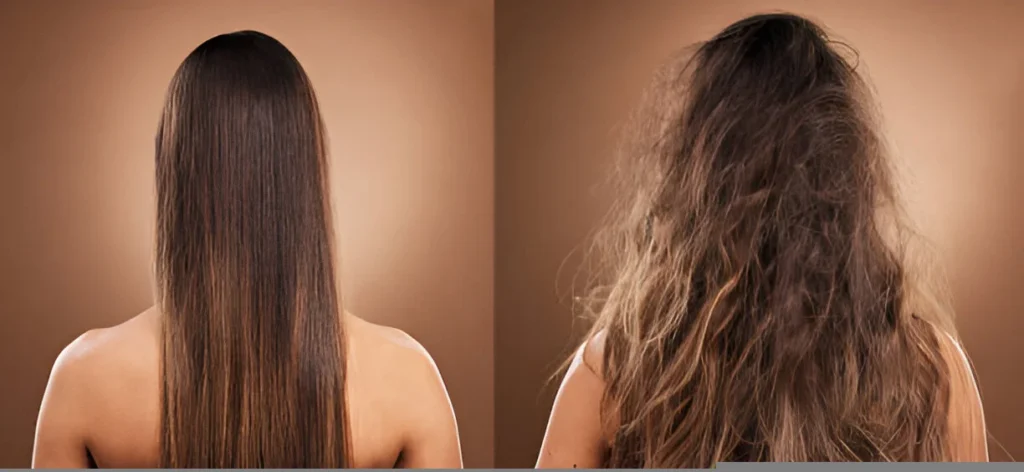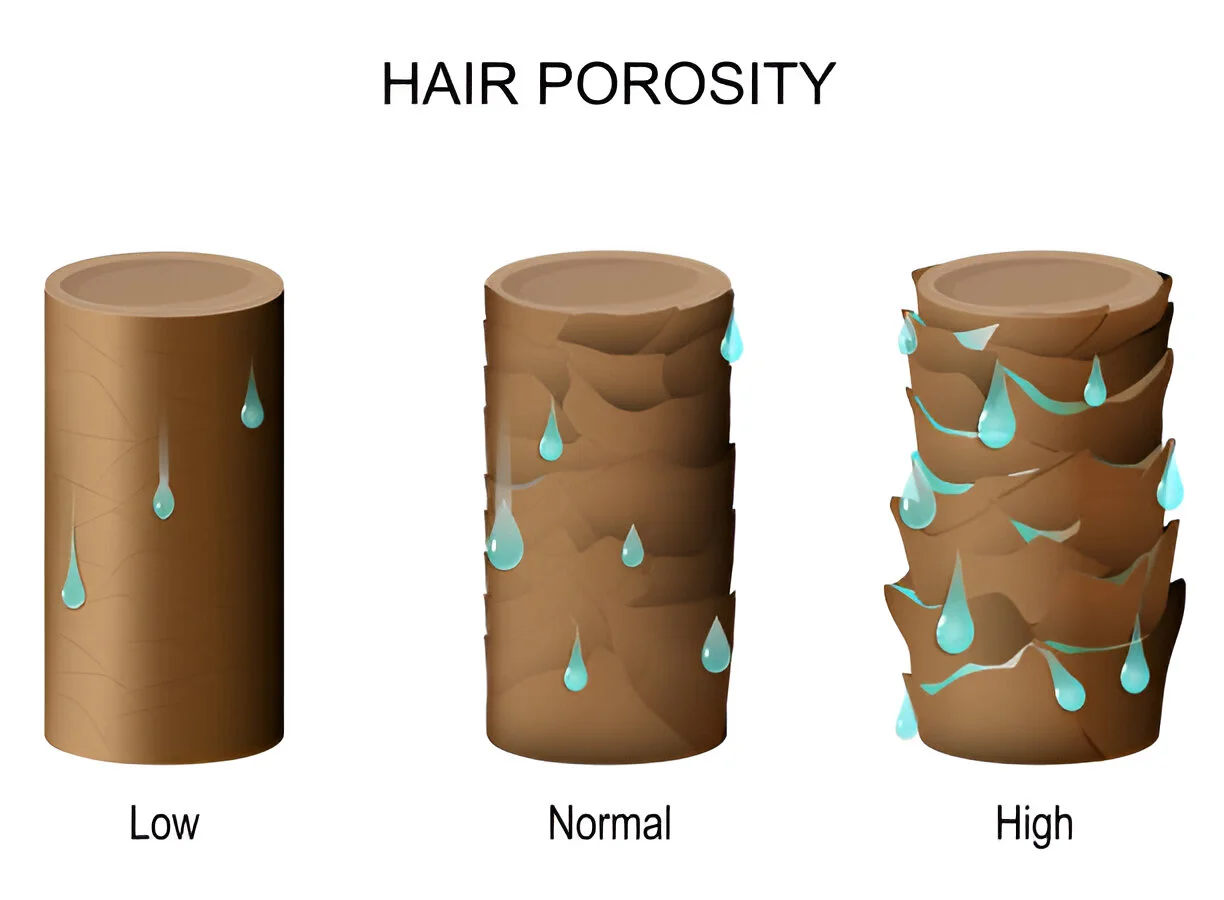Picture this: you’ve invested in countless hair products, diligently followed numerous routines, yet your strands still feel perpetually parched, unmanageably frizzy, and increasingly damaged. That distinct frustration when your tresses seem to drink up every nourishing product but retain absolutely none of the benefits resonates deeply with high porosity hair warriors. The cycle feels relentless—spending considerable sums on so-called “miracle” treatments only to watch your precious locks continue breaking and appearing lifeless despite your best efforts.
Take heart. Understanding and properly nurturing high porosity hair can transform your struggling strands from fragile to fabulous, and remarkably, this transformation can unfold more rapidly than you might expect. This comprehensive guide illuminates the path toward healthier, more resilient hair by addressing the unique needs of your high porosity strands.
What is High Porosity Hair? Understanding the Basics

Before diving into solutions, grasping what makes your hair “high porosity” provides essential context for everything that follows. Unlike its low porosity counterpart (where cuticles lie flat and tightly sealed), high porosity hair features cuticles that remain lifted or damaged, creating microscopic gaps along each strand.
Signs You Have High Porosity Hair
Wondering if your hair falls into this category? Look for these telltale indicators:
- Hair that dries with surprising speed after washing
- Strands that absorb water instantly upon contact
- Frequent tangling and breakage despite gentle handling
- Persistent dryness regardless of regular conditioning
- Products that seem to disappear into your hair without lasting effects
- Difficulty maintaining moisture throughout the day
- Hair that feels rough or coarse to the touch
The Science Behind Hair Porosity
The structural characteristics of high porosity hair explain its challenging behavior. Those raised cuticles allow moisture to enter rapidly but escape just as quickly—like trying to fill a leaky bucket. This fundamental issue typically stems from several possible sources:
- Heat damage from styling tools
- Chemical processing (coloring, relaxing, perming)
- Environmental stressors like sun exposure and pollution
- Mechanical damage from brushing or harsh handling
- Genetic predisposition
The beauty industry increasingly recognizes porosity as equally important to hair type when determining proper care protocols. Your 3C curls or straight strands merely represent shape—porosity reveals how your hair interacts with moisture and products.
The High Porosity Hair Care Framework: 4 Pillars for Quick Recovery
Addressing high porosity concerns requires a multifaceted approach. Each pillar contributes significantly to restoring balance and health to compromised strands.

1. Moisture Retention Strategies
High porosity hair resembles a sieve rather than a vessel—you’ll need specialized techniques to help it actually hold moisture:
- Deep conditioning protocols: Increase frequency to twice weekly with heat. Twenty minutes under a thermal cap dramatically improves penetration compared to standard conditioning.
- Water-based moisturizers before oils: Always layer properly—water-based products first, followed by cream-based products, and finally oils to seal. This sequence maximizes moisture retention.
- Humectant-rich ingredients: Seek out glycerin, honey, and aloe vera, which draw moisture from the environment into your strands. However, adjust usage based on climate—in extremely dry conditions, humectants can potentially pull moisture from your hair instead.
- pH-balanced products: Hair with raised cuticles benefits immensely from slightly acidic products (pH 4.5-5.5) that help temporarily flatten those cuticles, sealing in goodness.
Many professionals recommend overnight deep conditioning treatments for particularly parched high porosity strands. Simply apply your conditioner, cover with a shower cap, and rinse thoroughly in the morning for intensified results.
2. Protein Balance Techniques
High porosity hair typically suffers from protein deficiency since those gaps in the cuticle layer allow essential proteins to leach out easily. Restoring this balance proves crucial:
- Recognizing protein needs: Watch for excessive elasticity (hair stretches significantly before breaking) or a gummy texture when wet—both indicate protein deficiency.
- Protein treatment frequency: Begin with weekly protein treatments during your repair phase, then decrease to bi-weekly maintenance sessions.
- Protein-moisture calendar: Create an alternating schedule between deep moisture treatments and protein treatments to avoid overloading with either component.
- Kitchen protein boosters: Eggs, plain yogurt, and rice water rinses offer accessible protein sources between commercial treatments.
The protein-moisture balance represents perhaps the most delicate aspect of high porosity hair care. Too much protein leads to brittle, stiff strands, while insufficient protein results in mushy, breaking hair. Journal your treatments and results to identify your personal sweet spot.
3. Protective Styling Methods
Minimizing manipulation proves particularly crucial for fragile high porosity strands:
- Low-manipulation styles: Twisted updos, loose braids, and buns reduce daily handling while protecting fragile ends.
- Pre-protective style preparation: Always thoroughly moisturize, protein-treat if needed, and detangle gently before installing any protective style.
- Duration guidelines: Even “protective” styles become damaging when left in too long. Limit most styles to 2-3 weeks maximum to prevent matting and allow for proper cleansing.
- Edge protection: Pay special attention to hairline areas, which typically show damage first. Choose gentler products and apply less tension to these sensitive areas.
Even when wearing protective styles, continue moisturizing regularly through techniques like misting with water-based refreshers followed by light oil to seal.
4. Damage Prevention Practices
Preventing additional damage while healing existing issues accelerates your recovery timeline:
- Heat styling alternatives: Embrace heatless curling methods using fabric strips, flexi-rods, or braiding techniques.
- UV protection: Just as your skin needs sunscreen, your hair benefits from UV protectants—particularly important for high porosity strands, which can experience accelerated damage from sun exposure.
- Nighttime protection: Invest in a satin or silk pillowcase, or alternatively, wrap your hair nightly in a satin scarf to prevent friction-based damage and moisture loss.
- Water quality management: Consider a shower filter to remove chlorine and heavy metals that can exacerbate porosity issues.
Many overlooked habits contribute to porosity problems—excessive brushing, towel-drying roughly, or even water temperature (extremely hot water further raises cuticles). Addressing these subtle factors delivers disproportionate benefits.
Quick-Fix Solutions for High Porosity Hair Emergencies
Sometimes you need immediate intervention for particularly challenging situations:
Immediate Rescue Treatments
- 20-minute moisture infusion protocol: Apply a moisturizing conditioner mixed with a tablespoon of honey and 5 drops of your preferred oil. Cover with a shower cap and apply gentle heat with a blow dryer on low setting for 5 minutes, then allow to sit for 15 additional minutes before rinsing.
- Emergency protein treatments: When dealing with sudden excessive breakage, try an egg mask (one egg beaten with a tablespoon of olive oil) applied for 20 minutes before thoroughly rinsing with cool water.
- Quick sealing method: Keep a travel-sized spray bottle filled with water and a few drops of glycerin. When unexpected humidity strikes, mist lightly and immediately apply a pea-sized amount of butter-based sealant to ends and surface strands.
Product Cocktailing for Fast Results
Strategic product combinations often outperform individual solutions:
- Honey + conditioner: Adding a teaspoon of raw honey to your regular conditioner boosts its humectant properties for enhanced moisture retention.
- Layering techniques: Apply leave-in conditioner while hair remains soaking wet, then immediately follow with a cream-based styler, and seal with an oil-based product within minutes to trap maximum moisture.
- Incompatible combinations: Never mix protein-heavy products with other proteins in the same session, and avoid combining silicone-based products with natural oils, as this creates buildup that prevents proper moisture absorption.
The Ultimate High Porosity Hair Product Guide
Selecting appropriate products fundamentally impacts your results. This comparative overview highlights crucial considerations:
| Product Type | Key Ingredients to Seek | Ingredients to Avoid | Why It Matters |
| Shampoos | Aloe Vera, Glycerin, Cocoa Butter | Sulfates, Alcohol, Silicones | Cleansing without stripping essential moisture prevents further porosity issues |
| Conditioners | Shea Butter, Avocado Oil, Banana Extract | Drying Alcohols, Heavy Waxes | Sufficient slip and moisture content supports easy detangling without breakage |
| Leave-ins | Aloe Vera, Honey, Marshmallow Root | Petroleum, Mineral Oil | Lightweight hydration forms the foundation of your moisture retention strategy |
| Oils & Sealants | Jojoba Oil, Castor Oil, Almond Oil | Heavy Silicones, Petroleum | Properly sealed cuticles dramatically extend moisture retention time |
Rather than recommending specific brands, focus on ingredient lists that prioritize these beneficial components while avoiding potential irritants. Products labeled for “dry,” “damaged,” or “moisture-seeking” hair typically address high porosity needs effectively.
7-Day High Porosity Hair Transformation Plan

Implement this structured approach for noticeable improvements within a week:
Day 1: Assessment and Clarifying
Begin with a clean slate:
- Document your current hair condition with photos from multiple angles
- Use a clarifying shampoo to remove all product buildup
- Follow with a moisturizing apple cider vinegar rinse (1 tablespoon ACV to 2 cups water) to balance pH
- Apply a moisturizing conditioner, focusing on ends
Day 2-3: Intensive Repair Phase
Focus on rebuilding structural integrity:
- Apply a balanced protein treatment following package instructions
- Follow with a moisture-rich deep conditioner under heat for 30 minutes
- Allow hair to air-dry completely whenever possible
- Sleep with a satin bonnet to preserve moisture
Day 4-5: Moisture Loading Protocol
Concentrate on hydration saturation:
- Implement the “baggy method” overnight (apply leave-in conditioner to ends, cover with plastic cap)
- Use leave-in conditioner while hair remains soaking wet from washing
- Apply lightweight oil, paying special attention to the ends and midshaft areas of your hair.
- Minimize manipulation during these crucial hydration days
Day 6-7: Protective Styling and Maintenance
Lock in your progress:
- Choose a simple protective style appropriate for your hair length
- Apply a light moisturizer before styling
- Secure ends carefully to prevent friction damage
- Compare current hair condition with your day 1 documentation
Many notice significant texture improvements, reduced frizz, and enhanced shine even within this abbreviated timeframe. The key lies in consistency and following each step precisely.
Lifestyle Factors That Impact High Porosity Hair Health
External practices significantly influence internal hair structure:
Nutrition for Stronger Hair
Your diet directly impacts hair integrity:
- Prioritize protein-rich foods like eggs, fish, and legumes to support keratin production
- Increase omega-3 fatty acids through walnuts, flaxseeds, and fatty fish to improve moisture retention
- Ensure adequate biotin intake from avocados, nuts, and sweet potatoes to support overall hair health
- Maintain thorough hydration—aim for at least 64 ounces of water daily
Stress Management for Hair Recovery

The mind-hair connection proves surprisingly significant:
- Chronic stress increases cortisol levels, which can interfere with normal hair growth cycles.
- Implement simple stress-reduction techniques like deep breathing or brief meditation sessions
- Prioritize quality sleep (7-9 hours) to support cellular repair processes
- Consider gentle scalp massage to improve circulation while reducing tension
Common Mistakes People with High Porosity Hair Make
Avoid these frequent pitfalls that undermine progress:
- Over-conditioning without protein balance: Sometimes more moisture isn’t the answer—protein balance remains equally crucial
- Using incorrect drying methods: Rough towel-drying further damages cuticles; pat gently with microfiber alternatives instead
- Applying products in improper order: Always sequence from lightest to heaviest (water-based to oil-based)
- Neglecting regular trims: Split ends travel upward, creating more damage; maintain 8-12 week trimming schedules
- Mixing incompatible ingredients: Some combinations create barriers that prevent proper absorption
Seasonal Adjustments for High Porosity Hair Care
Environmental conditions necessitate strategic modifications:
Summer Protection Strategies
Heat and humidity require defensive planning:
- Increase UV protection through hats, scarves, or commercial UV hair protectants
- Pre-treat hair before swimming with a thorough fresh water soak and conditioner application
- Implement anti-humidity techniques like botanical gels with hold properties
Winter Moisture Retention Methods
Cold weather introduces different challenges:
- Combat indoor heating dryness with regular moisture sprays
- Consider overnight deep conditioning treatments weekly
- Protect hair from friction against winter clothing with protective styling
- Implement static control through light oil applications
How to Maintain Progress Long-Term
Sustainability ensures lasting results:
- Schedule quarterly porosity assessments using the float test (healthy hair should eventually float rather than sink immediately)
- Gradually transition from intensive repair protocols to maintenance routines
- Rotate products seasonally to prevent buildup and plateau effects
- Maintain detailed records of treatments and results to identify your optimal routine
Success Stories: Before and After Transformations
Real-world results provide motivation and context:
Take Sarah, whose color-treated curls exhibited classic high porosity symptoms—constant frizz, rapid drying, and persistent breakage. After implementing this framework for six weeks, her curl definition dramatically improved, moisture retention extended from hours to days, and breakage reduced by approximately 80%.
Or consider Marcus, whose high porosity locs suffered from environmental damage and improper previous care. By focusing specifically on protein-moisture balance and protective covering at night, his locs regained luster and strength within a month of consistent application.
Conclusion
Transforming high porosity hair requires patience alongside proper technique. While overnight miracles remain unrealistic, implementing these targeted strategies can produce visible improvements within days and substantial transformation within weeks. Remember that consistency ultimately determines your success—your hair accumulated damage over time, and healing follows a similar gradual timeline.
Begin by thoroughly understanding your hair’s specific needs, follow the framework outlined here, and continually adjust based on your observations. Listen to your hair’s responses—it communicates clearly through texture, elasticity, and appearance when something works or doesn’t.
With dedicated attention and the proper approach, your high porosity hair can evolve from a source of frustration to your crowning glory. The journey demands effort, but the rewards—healthy, vibrant, manageable hair—make every step worthwhile.
FAQs About High Porosity Hair
How quickly can I see improvements in my high porosity hair?
With faithful application of appropriate high porosity hair techniques, most people notice initial improvements within 7-14 days. The first changes typically include reduced frizz, better moisture retention throughout the day, and decreased tangling. More substantial structural improvements to high porosity hair may require several weeks of consistent care, particularly if your hair suffered significant damage previously.
Can high porosity hair be permanently fixed?
While you cannot completely alter your natural hair porosity level, damaged high porosity hair can experience remarkable improvement through proper care. Consistent moisture-protein balancing and protective practices help manage high porosity hair effectively and minimize its challenging characteristics. Over time, new growth will reflect your natural porosity level, while existing damaged portions become progressively healthier with continued care.
What’s the difference between high porosity hair and just damaged hair?
All high porosity hair exhibits raised cuticles, but not all damaged hair necessarily shows high porosity characteristics. Some hair damage affects the inner cortex while leaving cuticles relatively intact. However, most prolonged or severe damage eventually manifests as high porosity conditions if left unaddressed. Understanding whether your porosity is naturally high or damage-induced helps determine whether your focus should be repair or ongoing management.
How often should I deep condition hair with high porosity?
High porosity hair typically benefits from deep conditioning once weekly using heat. During intensive repair phases, twice-weekly deep conditioning sessions may accelerate high porosity hair recovery. Always ensure that moisture treatments are complemented with the appropriate protein supplements to effectively maintain structural integrity. Observe your hair’s response—excessive softness without elasticity suggests reducing conditioning frequency, while persistent dryness indicates increasing sessions.
Can I color my high porosity hair safely?
Coloring already high porosity hair demands extraordinary caution. If coloring proves necessary, choose demi-permanent options rather than permanent formulations, work with professionals familiar with high porosity hair challenges, and implement intensive pre and post-color care routines to minimize additional damage. Always schedule protein treatments 1-2 weeks before coloring, and follow immediately after with moisture-rich deep conditioning.
Does high porosity hair need protein in every wash?
Not necessarily. While high porosity hair typically requires more protein than other types, incorporating protein into every wash risks protein overload, resulting in brittle, stiff strands. A more balanced approach includes light protein treatments weekly during restoration phases and deeper protein treatments monthly, adjusting frequency based on your high porosity hair’s specific response patterns. Watch for elasticity changes as your primary indicator of protein needs.
What’s the best way to dry high porosity hair without causing more damage?
Air drying represents the ideal approach for high porosity hair whenever possible. When time constraints exist, use microfiber towels or old t-shirts to gently blot excess water, followed by diffusing on low heat with appropriate heat protectant if absolutely necessary. Never vigorously rub high porosity hair with conventional towels, as this mechanical action further raises cuticles and increases frizz. Consider plopping techniques that allow gentle drying without manipulation.








6 thoughts on “4 Essential Pillars: Boost High Porosity Hair Health Fast”